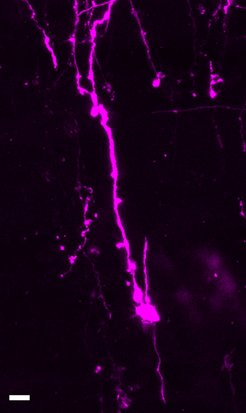To proliferate or not to proliferate
Shape of neural progenitor cells influences brain size
The brains of different mammals vary significantly in size. During human evolution, the size of the brain and the number of neurons therein increased profoundly, especially in a particular region called the neocortex, which is the seat of our higher cognitive abilities. Neurons are generated by neural progenitor cells, and more neural progenitors means more neurons and a bigger brain. Past studies had implicated one specific class of neural progenitors, called basal progenitors, as a key driver of neocortex expansion. However, it remained largely unknown what underlies the ability of basal progenitors to proliferate, that is to produce more basal progenitors. Researchers at the Max Planck Institute of Molecular Cell Biology and Genetics in Dresden now identified an underlying mechanism. They found that the shape of those cells determines how much they proliferate. This suggests that cell shape is a key cell biological feature contributing to the evolutionary expansion of the neocortex.

Why did the human neocortex expand so profoundly during evolution? A bigger neocortex is associated with an increased number of neurons and can provide better cognitive abilities. Neurons are produced during fetal development by progenitor cells. Neocortical progenitor cells in human are more proliferative than in other mammals, which means that they divide more times, generating additional progenitors before they produce neurons. As a consequence, the final number of neocortical neurons is increased. Among the different classes of neocortical progenitors, the so-called basal progenitors are thought to be the driving force for a bigger brain. It was already known that basal progenitors come in different shapes, with or without cell extensions, but it was unknown what the function of these extensions was and whether their number differed across mammalian species.
Researchers in the group of Wieland Huttner at the Max Planck Institute of Molecular Cell Biology and Genetics sought to address this question. With the support of colleagues from the University Hospital Carl Gustav Carus in Dresden and the Max Planck Institute for Experimental Medicine in Göttingen, they compared and quantified the shape of basal progenitors in the developing neocortex of mice, ferrets, and humans. They found that human basal progenitors have more cell extensions than those of mice and ferrets. That was new to the science world. Might that have something to do with the enhanced proliferative capacity of human basal progenitors? Nereo Kalebic, the first author of the study, explains: “First, we wanted to know why human basal progenitors have more extensions, and discovered that the protein PALMDELPHIN, which is associated with the inner side of the cell membrane, enables the growth of additional extensions. There it was – the unknown mechanism that influences the shape of basal progenitor cells!” Nereo continues: “Secondly, we also found out that when a basal progenitor has more extensions, its ability to proliferate is increased, which ultimately results in the production of more neurons.”
The researchers showed this by introducing human PALMDELPHIN into the embryonic neocortex of mice and ferrets, which caused the growth of more extensions on basal progenitors and an increase in their proliferation. In contrast, when the expression of PALMDELPHIN was disrupted in fetal human neocortical tissue, the number of basal progenitor extensions and basal progenitor proliferation were reduced. The researchers' findings culminated in the novel concept that a greater number of cell extensions enabled basal progenitors to more effectively receive pro-proliferative signals from their environment.
This study shows for the first time that the shape of a progenitor cell causes a change in proliferation. Wieland Huttner, the supervisor of the study, summarizes: “Our findings offer a missing link between the shape of basal progenitors and their ability to proliferate and thus create a bigger pool of progenitor cells, which is required for the production of a greater number of neurons. This suggests that changes in basal progenitor cell shape may have contributed to the evolutionary expansion of the human neocortex.”












